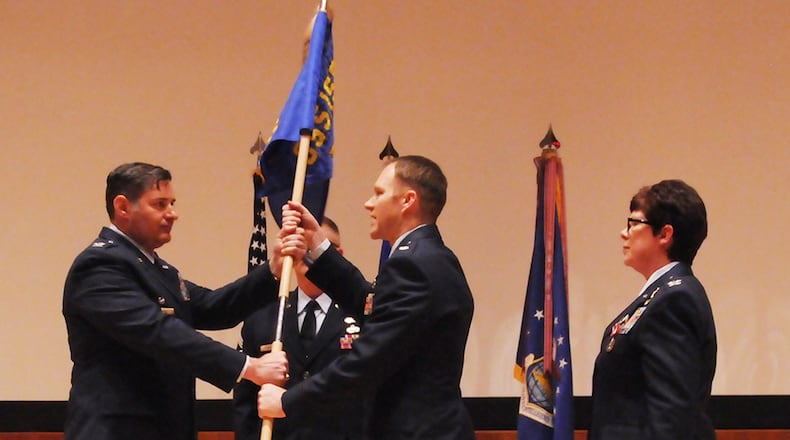The change of command is rooted in military history dating back to the 18th Century. At that time, organizational flags were developed with color arrangements and symbols unique to each particular unit. The flag served as a rallying point and reminder of their allegiance to their leader during battle. To this flag and the commander, military members dedicated their loyalty and trust. When a change of command took place, the flag was passed to the individual assuming command in the presence of the entire unit. All unit members could witness their new leader assume responsibility and trust associated with the position of commander. He, or she, who possessed the flag also held the unit members’ allegiance.
Since assuming command of the 71 IS on May 11, 2015, Spears led the Air Force Reserve Command’s only geospatial, measurement, and signatures intelligence squadrons from initial operating capability to full operating capability three months ahead of schedule. She also directed an innovative recruiting strategy, nearly doubling squadron personnel, increasing manning to 109 percent.
Col. Spears credited her success to the support she received from her parents, her husband, and all the Airmen of the 71 IS.
“This isn’t the first squadron I’ve commanded,” she said. “It is, however, the best squadron I’ve commanded.”
Additionally, she led 61 squadron analysts in the execution of 42,736 mission hours, increasing active duty engagement hours by 95 percent and providing over 1,800 national-level intelligence products for deployed warfighters and senior Air Force leaders.
Lt. Col. Bernkopf, an Air Force Academy Top Graduate, previously served as Director of Operations, 71st IS where he led over 60 personnel in ensuring the operational integration of trained and ready Reserve personnel into the National Air and Space Intelligence Center, Geospatial and Signatures Intelligence Group.
In his acceptance speech, Bernkopf used a football example to illustrate how units should be Introspective and humble in their success.
“On April 16th of 2000, the New England patriots selected Tom Brady in the 6th round,” he said. “In terms of return on investment, it was the greatest pick in NFL history! The Patriots general management didn’t pat themselves on back. Instead, they were disappointed that they missed all of Brady’s intangible assets and waited until the 6th round. In their moment of success, they were humble and introspective enough to find an opportunity to improve.”
Bernkopf urged the 71 IS to follow this example and to closely examine their own processes so they can constantly find ways to improve.
655 ISRG Commander John D. McKaye spoke at the ceremony on the qualities both leaders possess.
“My first impressions of both of them were very similar,” he said. “They both were obviously very intelligent, knowledgeable and hard working. Col. Spears was already a solid leader, and in Lt. Col. Bernkopf I saw a future leader … both have worked together to make the 71st better, stronger and more efficient and effective.
“A change in leadership means an influx of new ideas and perspectives that help us remain the most powerful and respected Air Force in the world. I have no doubt, in fact I know, that the 71st will continue to thrive and grow under the leadership of Lt. Col. Bernkopf.”
The 655 Intelligence Surveillance and Reconnaissance Group is dedicated to serving as the premier and most diverse ISR Group in the United States Air Force, delivering timely, reliable, accurate and actionable intelligence products enabling a decisive advantage over adversaries of the United States. The 655th consists of a headquarters and three tenant squadrons in Ohio, and 11 geographically separated units in California, Texas, Nebraska, Virginia, Florida and Maryland. For exciting and rewarding career opportunities with the 655th ISRG, contact a local Air Force Reserve recruiter or call 937-257-8117.
About the Author
